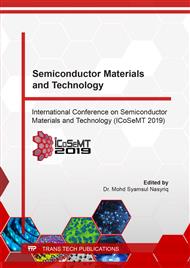[1]
M. A. Green, Commercial progress and challenges for photovoltaics, Nature Energy 1 (2016) 15015-1 – 15015-5.
Google Scholar
[2]
L. Andreani, A. Bozzola, P. Kowalczewski, M. Liscidini, L. Redorici, Silicon solar cells: toward the efficiency limits, Advances in Physics: X 4 (2018) 1548305-1 - 1548305-24.
DOI: 10.1080/23746149.2018.1548305
Google Scholar
[3]
Information on https://itrpv.vdma.org/.
Google Scholar
[4]
P. P. Altermatt, Y. Chen, Y. Yang, A. Ali, P. J. Verlinden, Optical properties of industrially mass-produced crystalline silicon solar cells and prospects for improvements, in Light, Energy and the Environment, OSA Technical Digest (online) (Optical Society of America, 2016), Paper JTh1A.2.
DOI: 10.1364/fts.2016.jth1a.2
Google Scholar
[5]
D. Payne, T.H. Fung, M.U. Khan, J.C. Campa, K. McIntosh, M. Abbott, Understanding the optics of industrial black silicon, AIP Conference Proceedings 1999 (2018) 050007-1-050007-8.
DOI: 10.1063/1.5049297
Google Scholar
[6]
Y. Wan, K. McIntosh, A. F. Thomson, Characterisation and optimisation of PECVD SiNx as an antireflection coating and passivation layer for silicon solar cells, AIP Advances 3 (2013) 032113-1 – 032113-14.
DOI: 10.1063/1.4795108
Google Scholar
[7]
C. Barugkin, F. J. Beck, K. R. Catchpole, Diffuse reflectors for improving light management in solar cells: A review and outlook, Journal of Optics 19 (2017) 014001-1 - 014001-2.
DOI: 10.1088/2040-8978/19/1/014001
Google Scholar
[8]
K. McIntosh, M. Abbott, B. Sudbury, Ray tracing isotextured solar cells, Energy Procedia 92 (2016) 122-129.
DOI: 10.1016/j.egypro.2016.07.041
Google Scholar
[9]
Information on https://www.pvlighthouse.com.au/.
Google Scholar
[10]
O. Höhn, N. Tucher, B. Bläsi, Impact of front side pyramid size on the light trapping performance of wafer-based silicon solar cells and modules, IEEE 44th Photovoltaic Specialist Conference (PVSC) (2017).
DOI: 10.1109/pvsc.2017.8366607
Google Scholar
[11]
S. C. Baker-Finch, K. R. McIntosh, Reflection of normally incident light from silicon solar cells with pyramidal texture, Progress in Photovoltaics: Research and Applications 19 (2011) 406-416.
DOI: 10.1002/pip.1050
Google Scholar
[12]
K. W. A. Chee, Z. Tang, H. Lü, F. Huang, Anti-reflective structures for photovoltaics: Numerical and experimental design, Energy Reports 4 (2018) 266-273.
DOI: 10.1016/j.egyr.2018.02.002
Google Scholar
[13]
Information on https://rredc.nrel.gov/solar//spectra/am1.5/.
Google Scholar
[14]
M. Z. Pakhuruddin, J. Huang, J. Dore, S. Varlamov, Enhanced light-trapping in laser-crystallised silicon thin-film solar cells on glass by optimised back surface reflectors, Solar Energy 150 (2017) 477-484.
DOI: 10.1016/j.solener.2017.04.069
Google Scholar
[15]
M. Z. Pakhuruddin, J. Huang, J. Dore, S. Varlamov, Rear texturing for light-trapping in laser-crystallised silicon thin-film solar cells on glass, Solar Energy 166 (2018) 213-219.
DOI: 10.1016/j.solener.2018.03.055
Google Scholar
[16]
M. Z. Pakhuruddin, J. Huang, J. Dore, S. Varlamov, Enhanced absorption in laser-crystallized silicon thin films on textured glass, IEEE Journal of Photovoltaics 6 (2016) 852-859.
DOI: 10.1109/jphotov.2016.2545410
Google Scholar
[17]
A. Najar, J. Charrier, P. Pirasteh, R. Sougrat, Ultra-low reflection porous silicon nanowires for solar cell applications, Optics Express 20 (2012) 16861-1 - 16861-10.
DOI: 10.1364/oe.20.016861
Google Scholar
[18]
J. K. Selj, D. Young, S. Grover, Optimization of the antireflection coating of thin epitaxial crystalline silicon solar cells, Energy Procedia 77 (2015) 248-252.
DOI: 10.1016/j.egypro.2015.07.035
Google Scholar
[19]
M. A. Green, The path to 25% silicon solar cell efficiency: History of silicon cell evolution, Progress in Photovoltaics: Research and Applications 17 (2009) 183-189.
DOI: 10.1002/pip.892
Google Scholar
[20]
F. Haase, S. Eidelloth, R. Horbelt, K. Bothe, E. G. Rojas, R. Brendel, Loss analysis of back-contact back-junction thin-film monocrystalline silicon solar cells, Journal of Applied Physics 110 (2011) 124510-1 – 124510-9.
DOI: 10.1063/1.3669388
Google Scholar
[21]
T. Tiedje, E. Yablonovitch, G. D. Cody, B. G. Brooks, Limiting efficiency of silicon solar cells, IEEE Transactions on Electron Devices, 31 (1984) 711-716.
DOI: 10.1109/t-ed.1984.21594
Google Scholar


